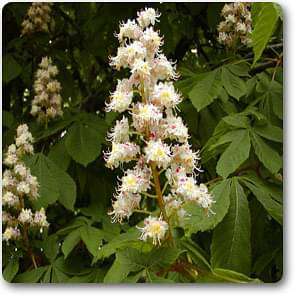Description
A beautiful landscape tree for parks and large lawns.
Aesculus hippocastanum, commonly called horsechestnut, is native to the Balkans. It is a medium to large deciduous tree that typically grows 50-75, tall with an upright oval-rounded crown. Light green palmate compound leaves emerge in spring, each with 7 (less frequently 5) spreading ovate-oblong leaflets to 4-10, long.
Plant Specifications
| Common Name | horse chestnut |
| Maximum Reachable Height | 50.00 to 75.00 feet |
| Flower Colour | red or yellow |
| Bloom Time | May |
| Difficulty Level | easy to grow |
Planting and care
Once roots begin sprouting, plant them in pots of composted soil. Horse chestnut seedlings can be planted in their permanent locations the following spring or fall, or whenever they reach about a foot or so tall.
Aesculus hippocastanum care
Easily grown in average, medium, well-drained soils in full sun to part shade. Prefers moist, fertile soils. Foliage tends to scorch and generally depreciate in dry conditions. This is a taprooted tree that once established is very difficult to transplant.
| Sunlight | Full sun to part shade |
| Watering | Medium |
| Soil | well-drained soil |
| Temperature | 4C |
| Fertilizer | Apply any organic fertilizer |
Aesculus hippocastanum special feature
It has been widely planted in the midwest as a street and shade tree.
Aesculus hippocastanum uses
Ornamental Use:
- The plant is used for ornamental purpose
- Its generally kep indoor in living room and in terrac area



Comment